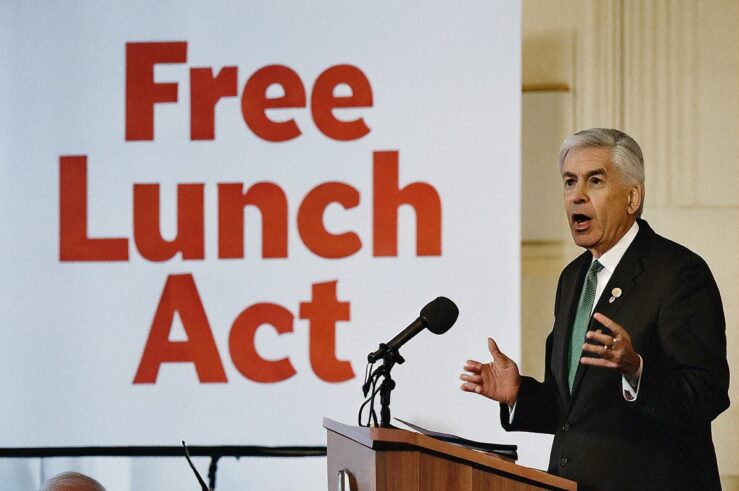I had the pleasure last month of hosting the first of a new annual roundtable discussion series on closing the rural digital divide through the University of Nebraska’s Space, Cyber, and Telecom Law Program. The purpose of the roundtable was to convene a diverse group of stakeholders — from farmers to federal regulators; from small municipal ISPs to billion dollar app developers — for a discussion of the on-the-ground reality of closing the rural digital divide.
The impetus behind the roundtable was, quite simply, that in my five years living in Nebraska I have consistently found that the discussions that we have here about the digital divide in rural America are wholly unlike those that the federally-focused policy crowd has back in DC. Every conversation I have with rural stakeholders further reinforces my belief that those of us who approach the rural digital divide from the “DC perspective” fail to appreciate the challenges that rural America faces or the drive, innovation, and resourcefulness that rural stakeholders bring to the issue when DC isn’t looking. So I wanted to bring these disparate groups together to see what was driving this disconnect, and what to do about it.
The unfortunate reality of the rural digital divide is that it is an existential concern for much of America. At the same time, the positive news is that closing this divide has become an all-hands-on-deck effort for stakeholders in rural America, one that defies caricatured political, technological, and industry divides. I have never seen as much agreement and goodwill among stakeholders in any telecom community as when I speak to rural stakeholders about digital divides. I am far from an expert in rural broadband issues — and I don’t mean to hold myself out as one — but as I have engaged with those who are, I am increasingly convinced that there are far more and far better ideas about closing the rural digital divide to be found outside the beltway than within.
The practical reality is that most policy discussions about the rural digital divide over the past decade have been largely irrelevant to the realities on the ground: The legal and policy frameworks focus on the wrong things, and participants in these discussions at the federal level rarely understand the challenges that define the rural divide. As a result, stakeholders almost always fall back on advocating stale, entrenched, viewpoints that have little relevance to the on-the-ground needs. (To their credit, both Chairman Pai and Commissioner Carr have demonstrated a longstanding interest in understanding the rural digital divide — an interest that is recognized and appreciated by almost every rural stakeholder I speak to.)
Framing Things Wrong
It is important to begin by recognizing that contemporary discussion about the digital divide is framed in terms of, and addressed alongside, longstanding federal Universal Service policy. This policy, which has its roots in the 20th century project of ensuring that all Americans had access to basic telephone service, is enshrined in the first words of the Communications Act of 1934. It has not significantly evolved from its origins in the analog telephone system — and that’s a problem.
A brief history of Universal Service
The Communications Act established the FCC
for the purpose of regulating interstate and foreign commerce in communication by wire and radio so as to make available, so far as possible, to all the people of the United States … a rapid, efficient, Nation-wide, and world-wide wire and radio communication service ….
The historic goal of “universal service” has been to ensure that anyone in the country is able to connect to the public switched telephone network. In the telephone age, that network provided only one primary last-mile service: transmitting basic voice communications from the customer’s telephone to the carrier’s switch. Once at the switch various other services could be offered — but providing them didn’t require more than a basic analog voice circuit to the customer’s home.
For most of the 20th century, this form of universal service was ensured by fiat and cost recovery. Regulated telephone carriers (that is, primarily, the Bell operating companies under the umbrella of AT&T) were required by the FCC to provide service to all comers, at published rates, no matter the cost of providing that service. In exchange, the carriers were allowed to recover the cost of providing service to high-cost areas through the regulated rates charged to all customers. That is, the cost of ensuring universal service was spread across and subsidized by the entire rate base.
This system fell apart following the break-up of AT&T in the 1980s. The separation of long distance from local exchange service meant that the main form of cross subsidy — from long distance to local callers — could no longer be handled implicitly. Moreover, as competitive exchange services began entering the market, they tended to compete first, and most, over the high-revenue customers who had supported the rate base. To accommodate these changes, the FCC transitioned from a model of implicit cross-subsidies to one of explicit cross-subsidies, introducing long distance access charges and termination fees that were regulated to ensure money continued to flow to support local exchange carriers’ costs of providing services to high-cost users.
The 1996 Telecom Act forced even more dramatic change. The goal of the 1996 Telecom Act was to introduce competition throughout the telecom ecosystem — but the traditional cross-subsidy model doesn’t work in a competitive market. So the 1996 Telecom Act further evolved the FCC’s universal service mechanism, establishing the Universal Service Fund (USF), funded by fees charged to all telecommunications carriers, which would be apportioned to cover the costs incurred by eligible telecommunications carriers in providing high-cost (and other “universal”) services.
The problematic framing of Universal Service
For present purposes, we need not delve into these mechanisms. Rather, the very point of this post is that the interminable debates about these mechanisms — who pays into the USF and how much; who gets paid out of the fund and how much; and what services and technologies the fund covers — simply don’t match the policy challenges of closing the digital divide.
What the 1996 Telecom Act does offer is a statement of the purposes of Universal Service. In 47 USC 254(b)(3), the Act states the purpose of ensuring “Access in rural and high cost areas”:
Consumers in all regions of the Nation, including low-income consumers and those in rural, insular, and high cost areas, should have access to telecommunications and information services … that are reasonably comparable to those services provided in urban areas ….
This is a problematic framing. (I would actually call it patently offensive…). It is a framing that made sense in the telephone era, when ensuring last-mile service meant providing only basic voice telephone service. In that era, having any service meant having all service, and the primary obstacles to overcome were the high-cost of service to remote areas and the lower revenues expected from lower-income areas. But its implicit suggestion is that the goal of federal policy should be to make rural America look like urban America.
Today universal service, at least from the perspective of closing the digital divide, means something different, however. The technological needs of rural America are different than those of urban America; the technological needs of poor and lower-income America are different than those of rich America. Framing the goal in terms of making sure rural and lower-income America have access to the same services as urban and wealthy America is, by definition, not responsive to (or respectful of) the needs of those who are on the wrong side of one of this country’s many digital divides. Indeed, that goal almost certainly distracts from and misallocates resources that could be better leveraged towards closing these divides.
The Demands of Rural Broadband
Rural broadband needs are simultaneously both more and less demanding than the services we typically focus on when discussing universal service. The services that we fund, and the way that we approach how to close digital divides, needs to be based in the first instance on the actual needs of the community that connectivity is meant to serve. Take just two of the prototypical examples: precision and automated farming, and telemedicine.
Assessing rural broadband needs
Precision agriculture requires different networks than does watching Netflix, web surfing, or playing video games. Farms with hundreds or thousands of sensors and other devices per acre can put significant load on networks — but not in terms of bandwidth. The load is instead measured in terms of packets and connections per second. Provisioning networks to handle lots of small packets is very different from provisioning them to handle other, more-typical (to the DC crowd), use cases.
On the other end of the agricultural spectrum, many farms don’t own their own combines. Combines cost upwards of a million dollars. One modern combine is sufficient to tend to several hundred acres in a given farming season. It is common for many farmers to hire someone who owns a combine to service their fields. During harvest season, for instance, one combine service may operate on a dozen farms during harvest season. Prior to operation, modern precision systems need to download a great deal of GIS, mapping, weather, crop, and other data. High-speed Internet can literally mean the difference between letting a combine sit idle for many days of a harvest season while it downloads data and servicing enough fields to cover the debt payments on a million dollar piece of equipment.
Going to the other extreme, rural health care relies upon Internet connectivity — but not in the ways it is usually discussed. The stories one hears on the ground aren’t about the need for particularly high-speed connections or specialized low-latency connections to allow remote doctors to control surgical robots. While tele-surgery and access to highly specialized doctors are important applications of telemedicine, the urgent needs today are far more modest: simple video consultations with primary care physicians for routine care, requiring only a moderate-speed Internet connection capable of basic video conferencing. In reality, literally megabits per second (not even 10 mbps) can mean the difference between a remote primary care physician being able to provide basic health services to a rural community and that community going entirely unserved by a doctor.
Efforts to run gigabit connections and dedicated fiber to rural health care facilities may be a great long-term vision — but the on-the-ground need could be served by a reliable 4G wireless connection or DSL line. (Again, to their credit, this is a point that Chairman Pai and Commissioner Carr have been highlighting in their recent travels through rural parts of the country.)
Of course, rural America faces many of the same digital divides faced elsewhere. Even in the wealthiest cities in Nebraska, for instance, significant numbers of students are eligible for free or reduced price school lunches — a metric that corresponds with income — and rely on anchor institutions for Internet access. The problem is worse in much of rural Nebraska, where there may simply be no Internet access at all.
Addressing rural broadband needs
Two things in particular have struck me as I have spoken to rural stakeholders about the digital divide. The first is that this is an “all hands on deck” problem. Everyone I speak to understands the importance of the issue. Everyone is willing to work with and learn from others. Everyone is willing to commit resources and capital to improve upon the status quo, including by undertaking experiments and incurring risks.
The discussions I have in DC, however, including with and among key participants in the DC policy firmament, are fundamentally different. These discussions focus on tweaking contribution factors and cost models to protect or secure revenues; they are, in short, missing the forest for the trees. Meanwhile, the discussion on the ground focuses on how to actually deploy service and overcome obstacles. No amount of cost-model tweaking will do much at all to accomplish either of these.
The second striking, and rather counterintuitive, thing that I have often heard is that closing the rural digital divide isn’t (just) about money. I’ve heard several times the lament that we need to stop throwing more money at the problem and start thinking about where the money we already have needs to go. Another version of this is that it isn’t about the money, it’s about the business case. Money can influence a decision whether to execute upon a project for which there is a business case — but it rarely creates a business case where there isn’t one. And where it has created a business case, that case was often for building out relatively unimportant networks while increasing the opportunity costs of building out more important networks. The networks we need to build are different from those envisioned by the 1996 Telecom Act or FCC efforts to contort that Act to fund Internet build-out.
Rural Broadband Investment
There is, in fact, a third particularly striking thing I have gleaned from speaking with rural stakeholders, and rural providers in particular: They don’t really care about net neutrality, and don’t see it as helpful to closing the digital divide.
Rural providers, it must be noted, are generally “pro net neutrality,” in the sense that they don’t think that ISPs should interfere with traffic going over their networks; in the sense that they don’t have any plans themselves to engage in “non-neutral” conduct; and also in the sense that they don’t see a business case for such conduct.
But they are also wary of Title II regulation, or of other rules that are potentially burdensome or that introduce uncertainty into their business. They are particularly concerned that Title II regulation opens the door to — and thus creates significant uncertainty about the possibility of — other forms of significant federal regulation of their businesses.
More than anything else, they want to stop thinking, talking, and worrying about net neutrality regulations. Ultimately, the past decade of fights about net neutrality has meant little other than regulatory cost and uncertainty for them, which makes planning and investment difficult — hardly a boon to closing the digital divide.
The basic theory of the Wheeler-era FCC’s net neutrality regulations was the virtuous cycle — that net neutrality rules gave edge providers the certainty they needed in order to invest in developing new applications that, in turn, would drive demand for, and thus buildout of, new networks. But carriers need certainty, too, if they are going to invest capital in building these networks. Rural ISPs are looking for the business case to justify new builds. Increasing uncertainty has only negative effects on the business case for closing the rural digital divide.
Most crucially, the logic of the virtuous cycle is virtually irrelevant to driving demand for closing the digital divide. Edge innovation isn’t going to create so much more value that users will suddenly demand that networks be built; rather, the applications justifying this demand already exist, and most have existed for many years. What stands in the way of the build-out required to service under- or un-served rural areas is the business case for building these (expensive) networks. And the uncertainty and cost associated with net neutrality only exacerbate this problem.
Indeed, rural markets are an area where the virtuous cycle very likely turns in the other direction. Rural communities are actually hotbeds of innovation. And they know their needs far better than Silicon Valley edge companies, so they are likely to build apps and services that better cater to the unique needs of rural America. But these apps and services aren’t going to be built unless their developers have access to the broadband connections needed to build and maintain them, and, most important of all, unless users have access to the broadband connections needed to actually make use of them. The upshot is that, in rural markets, connectivity precedes and drives the supply of edge services not, as the Wheeler-era virtuous cycle would have it, the other way around.
The effect of Washington’s obsession with net neutrality these past many years has been to increase uncertainty and reduce the business case for building new networks. And its detrimental effects continue today with politicized and showboating efforts to to invoke the Congressional Review Act in order to make a political display of the 2017 Restoring Internet Freedom Order. Back in the real world, however, none of this helps to provide rural communities with the type of broadband services they actually need, and the effect is only to worsen the rural digital divide, both politically and technologically.
The Road Ahead …?
The story told above is not a happy one. Closing digital divides, and especially closing the rural digital divide, is one of the most important legal, social, and policy challenges this country faces. Yet the discussion about these issues in DC reflects little of the on-the-ground reality. Rather advocates in DC attack a strawman of the rural digital divide, using it as a foil to protect and advocate for their pet agendas. If anything, the discussion in DC distracts attention and diverts resources from productive ideas.
To end on a more positive note, some are beginning to recognize the importance and direness of the situation. I have noted several times the work of Chairman Pai and Commissioner Carr. Indeed, the first time I met Chairman Pai was when I had the opportunity to accompany him, back when he was Commissioner Pai, on a visit through Diller, Nebraska (pop. 287). More recently, there has been bipartisan recognition of the need for new thinking about the rural digital divide. In February, for instance, a group of Democratic senators asked President Trump to prioritize rural broadband in his infrastructure plans. And the following month Congress enacted, and the President signed, legislation that among other things funded a $600 million pilot program to award grants and loans for rural broadband built out through the Department of Agriculture’s Rural Utilities Service. But both of these efforts rely too heavily on throwing money at the rural divide (speaking of the recent legislation, the head of one Nebraska-based carrier building out service in rural areas lamented that it’s just another effort to give carriers cheap money, which doesn’t do much to help close the divide!). It is, nonetheless, good to see urgent calls for and an interest in experimenting with new ways to deliver assistance in closing the rural digital divide. We need more of this sort of bipartisan thinking and willingness to experiment with new modes of meeting this challenge — and less advocacy for stale, entrenched, viewpoints that have little relevance to the on-the-ground reality of rural America.




